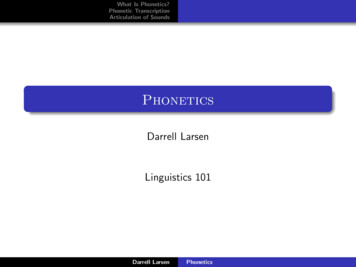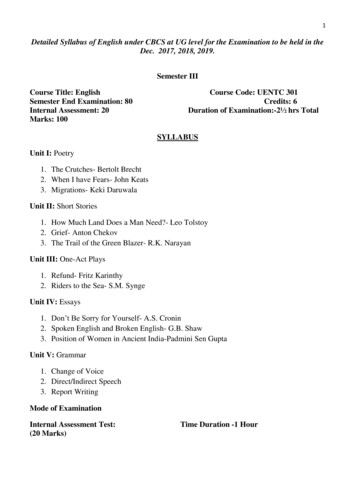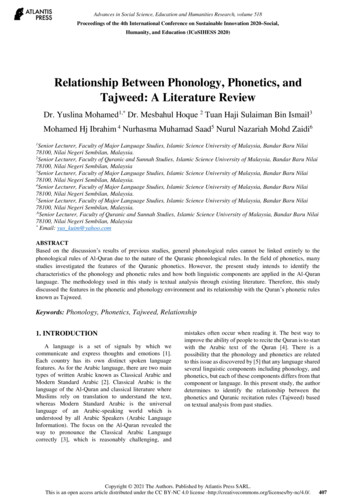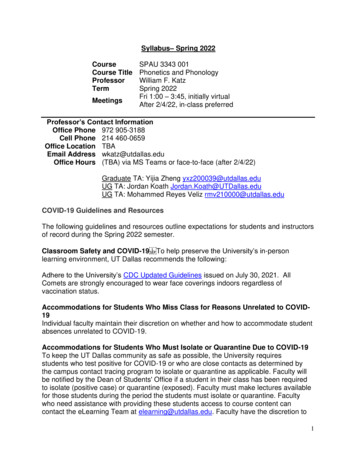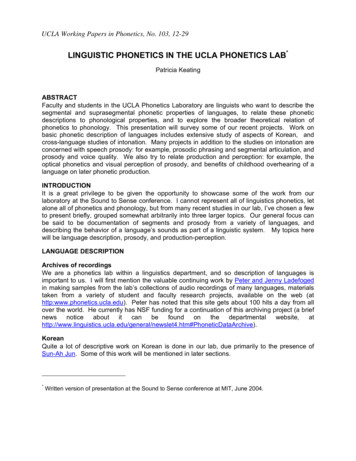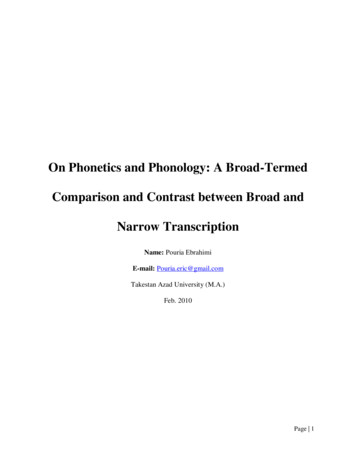
Transcription
On Phonetics and Phonology: A Broad-TermedComparison and Contrast between Broad andNarrow TranscriptionName: Pouria EbrahimiE-mail: Pouria.eric@gmail.comTakestan Azad University (M.A.)Feb. 2010Page 1
AbstractAs a subfield of linguistics, phonetics and phonology have as their main axis the concernof articulation of sounds; that is, how human beings produce speech. Although dated back over2000 years ago, modern contributions of scientists and scholars regarding phonetics andphonology have involved various fields of science and schools of thought such as philosophy,physiology, psychology, and even American structuralism. So, in line with all this, this studystarts with a general view toward phonetics and phonology holding the view of early contributorsand the role of aforementioned sciences and schools of thought. Then, thru representing figuresand tables, this study continues to consider two major aspects of the filed—namely broad andnarrow transcription. A broad-termed comparison and contract between the two, this study aimsto imply, indicates the former transcription harmful to the same extent, if not more one shouldlike to emphasize, it could be of assistance. It is because it does not represent the exact subtletiesof phonetics and, thus, prevent the person from achieving a native-like pronunciation.Key words: phonetics, phonology, broad transcription, narrow transcriptionPage 2
IntroductionPhonetics is the study, investigation, and description of sound system in a givenlanguage. Articulation of sounds is mostly concerned with the movement of speech organsincluding lips and tongue; but this is just the beginning. To investigate and describe soundsystems, one needs to pierce deeper where other organs and factors are in play. As in thelanguage of Clark and Yallop:Phonetics and phonology are concerned with speech . . . . Talking and listening to eachother are so much part of normal life that they often seem unremarkable. Yet, as in anyscientific filed, the curious investigator finds rich complexity beneath the surface. (1990,p. 1)Thus, phonetics is not as easy as describing /m/ sound as closing lips and suddenly let thetrapped air in mouth out, or to consider /w/ as a simple lip-rounding process and letting the airout. Put simply, a phonologist has to, first and foremost, investigate the place of articulation ofsounds, and then find a detailed way to make a sensible representation of all these sound forlearners to be able to achieve native-like pronunciation. The places of articulation, andarticulatory gestures, manner of articulation in fact, embrace the significance as they are ones tobe indicated and represented. En route for doing this, a phonologist has to transcribe what he orshe observes for ease of pronunciation. This transcription might have seemed to be in need of adivision in two major categories: (a) Broad Transcription, and (b) Narrow Transcription. As thename of each suggests, representation is either general or specific. This is routed in general ordetailed considerations of phonemes as the smallest and independent unit in a sound system.Broad transcription is a term to allocate very simple symbols to indicate the phoneticpronunciation of a given word. Narrow transcription, on the other hand, refers to more phoneticPage 3
details in showing the pronunciation of words (Ladefoged, 2006). Taking a phoneme like /p/ intoaccount, a phonologist prescribes a broad and a narrow transcription for it. Consider thefollowing tables;Table 1.Broad and narrow transcriptions of two lettersLetterBroad Transcription/p/pL/l/Narrow Transcription/p/ and /ph//l/ and /ɫ /This table indicates the variation between broad and narrow transcription of two samplephonemes. As with the table, narrow transcription is of more variety and seems to be useful in awider range of application to show the exact pronunciation of a given word. This is not, on thecontrary, what one can say about the application of broad transcription. Although it is a matter ofrelativity taking the phonetic symbols that dictionaries make use of to represent thepronunciation of words—i.e., they mostly have their own way of phonetic representation—this isan indication of the effort dictionaries make to put non-native speakers at ease when pronouncingwords.Table 2.Broad and narrow transcription variations in some word samplesSampleBroad Transcription/pliz/Please/kɪ l/Kill/snӕ p/SnapNarrow Transcription/pḷ i:z//khɪ ɫ //snӕ p/Although some samples like the third one in table two differ not even the least in broadand narrow transcriptions, this difference is mostly the case majority of words. Thus, broadtranscription would of very little help when the major learners of phonology are English asPage 4
foreign language learners (henceforth EFL learners). EFL learners are subject to be guided to theexact path or be misled if the material delivered is inexact. Therefore, using broad transcriptionto teach them the pronunciation of words would be of no help; maybe that is why dictionariesfollow narrow transcription, or one should like to say to the extent they can be in transcription.Having been worked on by a lot of scholars of a specific range of sciences and schools ofthought—this will be elaborated on later—phonetics and phonology seem to have a great deal ofimportance.Page 5
Literature ReviewThe field dates back over 2000 years ago when Sanskrit scholars of the time tried to focuson the articulation and pronunciation of ritual and keep them fixed over time and generations(Birjandi & Salmani-Nodoushan, 2005; Clark & Yallop, 1990). But the classification of sounds,in general, and vowels, in particular, seems to date back to 1653 when English mathematician,John Wallis tried to do so. Also, in the late 19th century, scholars of different fields like JanBaudouin de Courtenay, Ferdinand de Saussure, Leonard Bloomfield, and, perhaps mostimportantly, Edward Sapir contributed to the phonetic theory. As mentioned earlier, a lot offields have affected phonetic theory among which philosophy seems to have the most shares.Birjandi and Salmani-Nodoushan (2005) argue that philosophy has influenced almost everybranch of science endeavors. One should like to say that this influence is seen way illuminatedby the ideas of David Hume who believed the only way to accept and perceive things is thru fivesense modalities; if anything fails this principle, it should be “committed to the flames”. In linewith his principle, many linguists focused on those aspects which can be experienced thru fivesense modalities. Phonology, serving this purpose, was the only tangible part of language to bestudied.There were sciences which contributed to phonetic theory to a great deal. Physiology andpsychology are two of the most important ones in this regard. Ivan Pavlov was perhaps one ofthe most influential figures in the field of physiology who had experiments on dogs to show thatthey could learn behavior after times of repetition. His experiments ended in the notion ofBehaviorism in psychology; a school which according to Williams and Burden (1997), “. . . is anapproach to psychology that has its roots within positivism . . . . This approach arose out of theideas of early learning theorists who attempted to explain all learning in terms of some form ofPage 6
conditioning” (p. 8). Behaviorism seems to have had the greatest influence on phonetic theory asit favors the study of observable behavior (or response) in relation to the context (or stimuli)(Birjandi & Salmani-Nodoushan, 2005). This is generalizable to phonology as it is the study ofspeech production (a behavior) in different context (stimuli). Although psychology was basicallysupposed to be the study of inner feelings and experiences, Watson, the first to pose the notion ofbehaviorism, added the idea of its being measurable regarding all psychological elements asmuscular and glandular procedures measurable. This led to the emergence of stimulus-responsetheory—abbreviated as S-R Theory. This comes no surprise that phonology underwent theprinciples of the theory as it was a form of behavior observed in some context.During 19th and early 20th centuries, linguists in America connected language issues withhistorical matters. This accompanied and was supported by the orientation of the study ofAmerican Indian languages which lacked enough written texts regarding the past of thelanguage. The same went true for other types of languages. On the other hand many Americanlinguists at the time were anthropologists. Thus, speech-based study of language went on vogueand linguists turned their focus to form of languages; that is to say emphasis on the production ofwords on the basis of sounds rather than its other features such as syntax or semantics. They, as aresult, studied most immediately observable facet of language which was the sound system—especially that of American Indian languages, since they lacked previous studies as theirs wasrelatively new. This radical attention to form of language—attention to directly observable traitsof it which were the sounds—made American linguistics be known as Structural Linguistics. Inshort, American linguists‟ structuralism thru its attention to the sound system as the mostimmediately observable and measurable feature of language affected phonetic theory to a greatdeal. (Birjandi & Salmani-Nodoushan, 2005)Page 7
This movement continued to mid- and late-20th century with more detailed description ofsound system. It is the focus of phonetics to describe the place and manner of articulation ofsounds in a language—as already mentioned. Therefore, as with Yegnanarayana et al. (2008):The three broad categories of phonation types involving voice source vibration are: (a)modal (the normal vibration type), (b) breathy (where the vocal folds are held apart sothat the glottis is not closed completely), and (c) laryngealized (where the folds are heldstiffly and vibration is partially inhibited) (p. 1481).As this categorization of Yegnanarayana and colleagues show, this will not be so easy ajob to describe the place and manner of articulation of various sounds sometimes with the leastchange, sometimes with more than a single place of articulation, and differing from one languageto another or from an accent to another. This sheds light on the fact that the more detailed soundsare studied and represented, the better and easier EFL learners can achieve their final goal in aphonology course, undoubtedly native-like pronunciation.The following section includes some broad-termed information about phonetics andphonology thru the presentation of some figures and tables including the articulatory system, andthen draws to transcription of the sounds—some samples were given before.Page 8
MethodPhonetics is concerned with the articulation of sounds. That is, sound system of alanguage, English in this case, is taken into consideration regarding the place (or organs involvedin pronunciation of a sound) of articulation, and manner (or the positioning of these organs) allwith palmoneric air as the source of energy. Many think to learn phonetics is just the matter oflearning all a phonetician tries to uncover about sounds thru repetition of them. A phonetician, asaforementioned, does the job of transcribing what he or she observes; and this is so vital to thejob he or she does. There is good support for this by Ladefoged (2006), “Phonetic transcription isno more than a useful tool that phoneticians use in the description of speech. It is, however, avery important tool” (p. 33). Although Ladefoged suffices to name phonetic transcription „a veryimportant tool‟, it seems that it really is, for the only way to learn the pronunciation of alanguage is thru its phonetic transcription—i.e., to study written experiences of a phonetician.The smallest and at the same time independent unit of articulatory phonetics is called phoneme.As with the words of Birjandi and Salmani-Nodoushan (2005), “Linguists define phonemes asthe minimal unit of sound (or sometimes syntax). . . . The phonemes of a particular language arethose minimal distinct units of sound that can distinguish meaning in that language” (pp. 9-10).Phonemes in a language are divided into two major parts: (a) vowels of the language, and (b)consonants in a language. Let us not forget that phonetics is the study of sounds and not spellingof words; to take into consideration the three examples of fat, phone, and laugh all have thesound /f/, they are underlined, but in different spellings. So, as Ladefoged puts it, “We cannotrely on the spelling to tell us whether two sounds are members of different phonemes” (p. 34). Inline with the division of phonemes in a language, a phonetician‟s immediate job seems to be thePage 9
identification of place of articulation, since it is the most tangible thing to observe. Take thefollowing sample into consideration;Figure 1. A sample of place of articulation of some consonants, nasal plosions(Reprinted from Ladefoged, 2006; p. 62)What which is shown in Fig. 1 is just the place of articulation still too raw to beprescribed for learners and expect them to achieve the exact pronunciation of these. Thus, aphonetician should also tell about the manner of articulation of these sounds. In other words, heor she should tell about the positioning of organs involved in the production of sound—no mattervowels or consonants. Through this, EFL learners get one step closer to the final goal they wantto achieve. To transcribe consonants, the easiest way is to find contrasting phonemes in rhymewords such as in pie, tie, etc. It was already mentioned that spelling is not a good and reliablecriterion to transcribe phonemes; so, in the two italicized words the opening phoneme,respectively /p/, and /t/ are presented. But all this would end nowhere if the manner ofarticulation is ignored. That is, manner of articulation of sounds is identically, if not more,significant as the place of articulation. The subsequent figure is an indication of just consonantsincluding their place and manner of articulation.Page 10
Figure 2. Place and manner of articulation of consonants in English (Reprinted fromLadefoged, 2006; p. 43)Now, one‟s only job is to get familiar with concepts like approximants, fricatives asmanners, and bilabials, palate-alveolars. Let us take into account that the main axis of this studyis comparison and contrast between Broad and Narrow Transcription of sounds. These soundsare to be emphatically called raw to a great extent (c.f., Table 1). To propose these as final resultof observations and experiences of a phonetician is to introduce broad transcription as the onlyway to the phonation of sounds in a language.Part one of the job done, a phonetician should go through vowels and do the same withthem. That is to say that place and manner of articulation to introduce raw and broadtranscription of vowels seems to come next; but apparently this is too much of a burden incomparison with consonants. There is good deal of support by Ladefoged (2006) in this regard.He suggests:The transcription of contrasting vowels (the vowel phonemes) in English is more difficultthan the transcription of consonants for two reasons. First, accents of English differ morePage 11
in their use of vowels than in their use of consonants. Second, authorities differ in theirviews of what constitutes an appropriate description of vowels (p.38).Figure 3. A vowel chart representing relative vowel qualities thru some symbols(Reprinted from Ladefoged, 2006; p. 44)In contrast with what a phonetician transcribes for consonants, what he or she shows invowel chart seems to be narrower in the sense that factors like being tense and lax, fronted,centered, and back, etc. all along with the length of vowels have been taken into account in thischart.One should constantly bear in mind that to achieve the final aim of phonetic theory,gaining native-like pronunciation, necessitates a phonetician to transcribe these raw symbols in agenerally understandable approach. The most immediate thing that crosses a phonetician‟s mindis that there are two approaches to do this—namely broad and narrow transcription. The formeris concerned with presenting very simple symbols for the pronunciation of words whereas thelatter is more detailed in doing the same job.Page 12
As shown earlier in tables 1 and 2, although in some cases broad and narrow transcriptiondo not differ that much, providing EFL learners with directly narrow transcription would be ashortcut to what they want to get. Not only does narrow transcription differ from broad inrepresenting details, but also it is more detailed in waveform. Consider the following;Figure 4. The waveforms of words tie and die (Reprinted from Ladefoged, 2006; p. 57)As it can be easily seen in Fig. 4, even the waveform of a word including a phoneme withnarrow transcription is of more variation and more detailed. Another is the following to prove thesimplicity of phonemes which do not differ in broad and narrow transcription.Figure 5. The waveform of the word mat (Reprinted from Ladefoged, 2006; p. 59)Page 13
Again it is clear from Fig. 5, phonemes with the same broad and narrow transcriptionsare subject to be simpler in transcribing, waveform, and even pronunciation. But by this is notmeant that all transcription should be represented in broad style. But this is a token of howdifferent the pronunciation of words with differing broad and narrow transcription would be evenfrom person to person, closing the eyes to the difference from accent to accent and learner tolearner.Page 14
ConclusionThis study focused on broad and narrow transcription; basically it described both thrutables and figures, and then it started to draw to narrow transcription to prove it more useful—maybe the only approach to gain the final goal of phonetics courses. It did not undermine, neitherdid it focus, situations in which broad transcription would come handy. But by and large, narrowtranscription is more detailed even in the waveforms which represent words.Page 15
ReferencesBirjandi, P., & Salmani-Nodoushan, M. (2005). An introduction to phonetics. Tehran:Zabankadeh Publications.Clark, J., & Yallop, C. (1990). An introduction to phonetics and phonology. Oxford: Blackwellpublishers.Ladefoged, P. (2006). A course in phonetics. Rosenberg: Thomson Wadsworth.Yegnanarayana, B., Rajendran, S., Worku, H. S., & Dhananjaya, N. (2008). Analysis of glottalstops in speech signals. ISCA, 1481-1484.Williams, M., & Burden, R. (1997). Psychology for language teachers. Cambridge: CambridgeUniversity Press.Page 16
Many think to learn phonetics is just the matter of learning all a phonetician tries to uncover about sounds thru repetition of them. A phonetician, as aforementioned, does the job of transcribing what he or she observes; and this is so vital to the job he or she does. There is good support for this by Ladefoged (2006), "Phonetic transcription is

